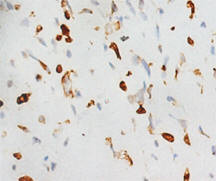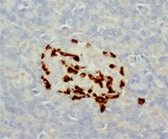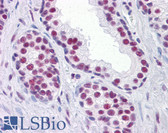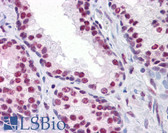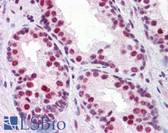 Loading... Please wait...
Loading... Please wait...- Call us on 443-686-9618
- Wish Lists
- My Account
- 0.00
- Home
- IHC Antibodies
- CBFA1/RUNX2 IHC Antibody
CBFA1/RUNX2 IHC Antibody
Product Description
Description |
Core binding factor A1 (CBFA1/RUNX2) is a runt-like transcription factor essential for osteoblast differentiation. This protein is a member of the RUNX family of transcription factors and has a Runt DNA-binding domain. It is essential for osteoblastic differentiation and skeletal morphogenesis and acts as a scaffold for nucleic acids and regulatory factors involved in skeletal gene expression. D'Souza et al. (1999) indicate a non-redundant role for Cbfa1 in tooth development that may be distinct from that in bone formation. In odontogenesis, Cbfa1 is not involved in the early signaling networks regulating tooth initiation and early morphogenesis but regulates key epithelial-mesenchymal interactions that control advancing morphogenesis and histodifferentiation of the epithelial enamel organ.
|
Catalog Number
|
IW-PA1224 |
Quantity
|
9 ml |
|
Host
|
Rabbit
|
|
Clone
|
Polyclonal
|
|
Isotype
|
Rabbit IgG
|
|
Immunogen
|
A synthetic peptide corresponding to a sequence at the C-terminal of human CBFA1, identical to the related rat and mouse sequence.
|
|
Purity
|
Immunogen affinity purified
|
|
Conjugate
|
Unconjugated
|
|
Species Reactivity
|
Human, mouse, rat. Not tested in other species. |
|
Positive Control
|
Human osteosarcoma
|
|
Cellular Localization
|
Cytoplasmic
|
|
Form
|
Ready to use solution in PBS with stabilizer and 0.01% sodium azide. No further dilution needed. Serum blocking step should be omitted.
|
|
Storage
|
Store at 2-8 °C. Do not freeze.
|
|
Applications
|
IHC-P: Heat induced epitope retrieval is required on formalin fixed paraffin sections. IHC-Fr: Not tested. ICC: Not tested.
|
|
Limitations
|
This product is intended for Research Use Only. Interpretation of the test results is solely the responsibility of the user.
|
|
Precautions
|
Users should follow general laboratory precautions when handling this product. Wear personal protective equipment to avoid contact with skin and eyes.
|
|
References
|
2. D'Souza, R. N.; Aberg, T.; Gaikwad, J.; Cavender, A.; Owen, M.; Karsenty, G.; Thesleff, I. : Cbfa1 is required for epithelial-mesenchymal interactions regulating tooth development in mice. Development 126: 2911-2920, 1999.
|

